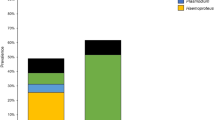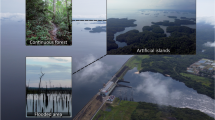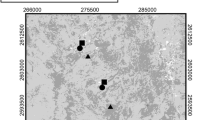Abstract
Numerous studies addressed the diversity of bird Plasmodium and Haemoproteus parasites. However, a few have been carried out in continental avian hotspot regions such as Brazil, a country with markedly different biomes, including Amazon, Brazilian Savanna, Atlantic Forest, Caatinga, Pantanal, and Pampas. We present the first study on hemosporidian (Haemosporida) parasites in free-living birds from an Atlantic Forest fragment where more than 80 avian species have been reported. Within this area, the São Paulo Zoo locates, and it is the fourth largest zoo in the world and the largest in Latin America. A total of 133 free-living bird samples representing 12 species were collected in the zoo, with the overall hemosporidian prevalence of 18 % by PCR-based diagnostics. Twenty-four positive PCR signals were reported from four different bird species, including migratory ones. Columba livia, an urban species, considered nowadays a pest in big cities, showed 100 % prevalence of Haemoproteus spp., mainly Haemoproteus columbae. We discuss the epidemiological importance of new parasites introduced by migratory birds in the São Paulo Zoo area and the risk it poses to the captive species, which are natives or exotics. We also warn about the influence these parasites can have on the biodiversity and the structure of host populations by altering the competitive interaction between the free-living and the captive birds.




Similar content being viewed by others
References
Adriano EA, Cordeiro NS (2001) Prevalence and intensity of Haemoproteus columbae in three species of wild doves from Brazil. Mem Inst Oswaldo Cruz 96:175–178
Altschul SF, Madden TL, Schäffer AA, Zhang J, Zhang Z, Miller W, Lipman DJ (1997) Gapped BLAST and PSI-BLAST: a new generation of protein database search programs. Nucleic Acids Res 25:3389–3402
Arzua M, Valim MP (2010) Bases para o estudo qualitativo e quantitativo em aves. In: Matter SV, Strauber FC, Accordi I, Piacentini V, Cândido JF Jr (eds) Ornitologia e Conservação: Ciência Aplicada, Técnicas de Pesquisa e Levantamento. Technical Books, Rio de Janeiro, pp 347–366
Atkinson CT, Thomas NJ, Hunter BC (2008) Parasitic diseases of wild birds. Wiley-Blackwell, Ames
Baptista LF, Trail PW, Horblit HM (1997) Rock dove (Columba livia). In: del Hoyo J, Elliott A, Sargatal J, Christie DA, de Juana E (eds) (2014). Handbook of the birds of the world alive. Lynx Edicions, Barcelona, Acesso: http://www.hbw.com/node/54097 em 26 de julho de 2015
Beadell JS, Gering E, Austin J, Dumbacher JP, Peirce MA, Pratt TK, Atkinson CT, Fleischer RC (2004) Prevalence and differential host-specificity of two avian blood parasite genera in the Australo-Papuan region. Mol Ecol 13:3829–3844
Belo NO, Passos LF, Júnior LM, Goulart CE, Sherlock TM, Braga EM (2009) Avian malaria in captive psittacine birds: detection by microscopy and 18S rRNA gene amplification. Prev Vet Med 88:220–224
Bensch S, Hellgren O, Pérez-Tris J (2009) MalAvi: a public database of malaria parasites and related haemosporidians in avian hosts based on mitochondrial cytochrome b lineages. Mol Ecol Resour 9:1353–1358
Bueno MG, Lopez RPG, Menezes RMT, Costa-Nascimento MJ, Lima GFMC, Araújo RAS, Guida FJV, Kirchgatter K (2010) Identification of Plasmodium relictum causing mortality in penguins (Spheniscus magellanicus) from São Paulo Zoo, Brazil. Vet Parasitol 173:123–127
Bukauskaitė D, Žiegytė R, Palinauskas V, Iezhova TA, Dimitrov D, Ilgūnas M, Bernotienė R, Markovets MY, Valkiūnas G (2015) Biting midges (Culicoides, Diptera) transmit Haemoproteus parasites of owls: evidence from sporogony and molecular phylogeny. Parasit Vectors 8:303
Cannell BL, Krasnec KV, Campbell K, Jones HI, Miller RD, Stephens N (2013) The pathology and pathogenicity of a novel Haemoproteus spp. infection in wild Little Penguins (Eudyptula minor). Vet Parasitol 197:74–84
Carboneras C, Kirwan GM (2014) White-faced whistling-duck (Dendrocygna viduata). In: del Hoyo J, Elliott A, Sargatal J, Christie DA, de Juana E (eds) 2014. Handbook of the birds of the world alive. Lynx Edicions, Barcelona, Acesso: http://www.hbw.com/node/52799 em 26 de julho de 2015
CBRO (2014) Comitê brasileiro de registros ornitológicos. Listas das aves do Brasil 11ª Edição. http://www.cbro.org.br. Accessed: January 01, 2014
CEMAVE/IBAMA (1994) Manual de anilhamento de aves silvestres, 2nd edn. IBAMA, Brasília, p 146
Chagas CRF, Valkiūnas G, Nery CVC, Henrique PC, Gonzalez IHL, Monteiro EF, Guimarães L, Kirchgatter K (2013) Plasmodium (Novyella) nucleophilum from Egyptian Goose in São Paulo Zoo, Brazil: microscopic confirmation and molecular characterization. Int J Parasitol Parasites Wildl 2:286–291
Clark NJ, Clegg SM, Lima MR (2014) A review of global diversity in avian haemosporidians (Plasmodium and Haemoproteus: Haemosporida): new insights from molecular data. Int J Parasitol 44:329–338
Del Hoyo J, Kirwan GM (1994) Rusty-margined Guan (Penelope superciliaris). In: del Hoyo J, Elliott A, Sargatal J, Christie DA, de Juana E (eds) Handbook of the birds of the world, vol 2, New World vultures to guineafowl. Lynx Edicions, Barcelona, pp 348–350
del Hoyo J, Elliott A, Sargatal J (1992) Handbook of the birds of the world. Volume 1: ostrich to ducks. Lynx Edicions, Barcelona
Develey PF, Endrigo E (2011) Guia de campo: Aves da Grande São Paulo. Aves e Fotos Editora, São Paulo
Donovan TA, Schrenzel M, Tucker TA, Pessier AP, Stalis IH (2008) Hepatic hemorrhage, hemocoelom, and sudden death due to Haemoproteus infection in passerine birds: eleven cases. J Vet Diagn Invest 20:304–313
Durrant KL, Beadell JS, Ishtiaq F, Graves GR, Olson SL, Gering E, Peirce MA, Milensky CM, Schmidt BK, Gebhard C, Fleischer RC (2006) Avian hematozoa in South America: a comparison of temperate and tropical zones. Ornit Monographs 60:98–111
Felippe-Bauer ML, Oliveira SJ (2001) Lista dos exemplares tipos de Ceratopogonidae (Diptera: Nematocera) depositados na Coleção Entomológica do Instituto Oswaldo Cruz, Rio de Janeiro, Brasil. Mem Inst Oswaldo Cruz 96:1109–1119
Ferrell ST, Snowden K, Marlar AB, Garner M, Lung NP (2007) Fatal hemoprotozoal infections in multiple avian species in a zoological park. J Zoo Wildl Med 38:309–316
Garnham PCC (1966) Malaria parasites and other haemosporidia. Blackwell Scientific, Oxford
Godfrey RD, Fedynich AM, Pence DB (1987) Quantification of the hematozoa in blood smears. J Wildl Dis 23:558–565
González AD, Lotta IA, García LF, Moncada LI, Matta NE (2015) Avian haemosporidians from Neotropical highlands: evidence from morphological and molecular data. Parasitol Int 64:48–59
Guix JC (1997) Exclusão geográfica e ecológica de Penelope obscura, Penelope superciliaris e Pipile jacutinga (Galliformes, Cracidae) no estado de São Paulo. Ararajuba 5:195–202
Hellgren O, Waldenström J, Bensch S (2004) A new PCR assay for simultaneous studies of Leucocytozoon, Plasmodium and Haemoproteus from avian blood. J Parasitol 90:797–802
Huelsenbeck JP, Ronquist F (2001) MRBAYES: Bayesian inference of phylogenetic trees. Bioinformatics 17:754–755
IUCN Red List (2015) [http://www.iucnredlist.org/]
Ishak HD, Dumbacher JP, Anderson NL, Keane JJ, Valkiūnas G, Haig SM, Tell LA, Sehgal RN (2008) Blood parasites in owls with conservation implications for the Spotted Owl (Strix occidentalis). PLoS One 3:e2304
Karamba KI, Kawo AH, Dabo NT, Mukhtar MD (2012) A survey of avian malaria parasite in Kano State, Northern Nigeria. Int J Biotechnol Mol Biol Res 3:8–14
Krone O, Waldenström J, Valkiūnas G, Lessow O, Müller K, Iezhova TA, Fickel J, Bensch S (2008) Haemosporidian blood parasites in European birds of prey and owls. J Parasitol 94:709–715
Lacorte GA, Félix GM, Pinheiro RR, Chaves AV, Almeida-Neto G, Neves FS, Leite LO, Santos FR, Braga EM (2013) Exploring the diversity and distribution of neotropical avian malaria parasites—a molecular survey from Southeast Brazil. PLoS One 8:e57770
Madge S, Burn H (1988) Wildfowl. Christopher Helm, London
Martínez-Vilalta A, Motis A, Kirwan GM (2014) Black-crowned Night-heron (Nycticorax nycticorax). In: del Hoyo J, Elliott A, Sargatal J, Christie DA, de Juana E (eds) Handbook of the birds of the world alive. Barcelona, Lynx Edicions, Acesso: http://www.hbw.com/node/52707 em 30 de julho
McClure HE, Poonswad P, Greiner EC, Laird M (1978) Haematozoa in the birds of Eastern and Southern Asia. St. John’s: Memorial University of Newfoundland.
Mikich AB (2002) A dieta frugívora de Penelope superciliaris (Cracidae) em remanescentes de florestas estacional semidecidual no centro-oeste do Paraná, Brasil e sua relação com Euterpe edulis (Arecaceae). Ararajuba 10:207–217
Motta ROC, Marques MVR, Ferreira JRFC, Andery DA, Horta RS, Peixoto RB, Lacorte GA, Moreira PA, Leme FOP, Melo MM, Martins NRS, Braga EM (2013) Does haemosporidian infection affect hematological and biochemical profiles of the endangered Black-fronted piping-guan (Aburria jacutinga)? PeerJ 1:e45
Njabo KY, Cornel AJ, Sehgal RN, Loiseau C, Buermann W, Harrigan RJ, Pollinger J, Valkiūnas G, Smith TB (2009) Coquillettidia (Culicidae, Diptera) mosquitoes are natural vectors of avian malaria in Africa. Malar J 8:193
Olias P, Wegelin M, Zenker W, Freter S, Gruber AD, Klopfleisch R (2011) Avian malaria deaths in parrots, Europe. Emerg Infect Dis 17:950–952
Orme CD, Davies RG, Burgess M, Eigenbrod F, Pickup N, Olson VA, Webster AJ, Ding TS, Rasmussen PC, Ridgely RS, Stattersfield AJ, Bennett PM, Blackburn TM, Gaston KJ, Owens IP (2005) Global hotspots of species richness are not congruent with endemism or threat. Nature 436:1016–1019
Rambaut A (2006) FigTree tree figure drawing toll version 1.4.0. Institute of Evolutionary Biology, University of Edinburgh [http://tree.bio.ed.ac.uk/software/figtree/).
Ribeiro SF, Sebaio F, Branquinho FC, Marini MA, Vago AR, Braga EM (2005) Avian malaria in Brazilian passerine birds: parasitism detected by nested PCR using DNA from stained blood smears. Parasitology 130:261–267
Ribeiro MC, Metzger JP, Martensen AC, Ponzoni FJ, Hirota MM (2009) The Brazilian Atlantic Forest: how much is left, and how is the remaining forest distributed? Implications for conservation. Biol Conserv 142:1141–1153
Scaglione FE, Pregel P, Cannizzo FT, Pérez-Rodríguez AD, Ferroglio E, Bollo E (2015) Prevalence of new and known species of haemoparasites in feral pigeons in northwest Italy. Malar J 14:99
Sebaio F, Braga EM, Branquinho F, Fecchio A, Marini MÂ (2012) Blood parasites in passerine birds from the Brazilian Atlantic Forest. Rev Bras Parasitol Vet 21:7–15
Sick H (1997) Ornitologia Brasileira, uma introdução. Nova Fronteira, Rio de Janeiro
Sigrist T (2014) Guia de campo Avis Brasilis—Avifauna Brasileira. Avis Brasilis, São Paulo, p 608
Sorci G, Cornet S (2010) Immunity and virulence in bird-parasite interactions. Open Ornithol J 3:33–40
Tavernier P, Saggese M, Van Wettere A, Redig P (2005) Malaria in an eastern screech owl (Otus asio). Avian Dis 49:433–435
Valkiūnas G (2005) Avian malaria parasites and other haemosporidia. CRC Press, New York, p 935
Valkiūnas G, Bensch S, Iezhova TA, Krizanauskiené A, Hellgren O, Bolshakov CV (2006) Nested cytochrome b polymerase chain reaction diagnostics underestimate mixed infections of avian blood haemosporidian parasites: microscopy is still essential. J Parasitol 92:418–422
Valkiūnas G, Zehtindjiev P, Dimitrov D, Krizanauskiene A, Iezhova TA, Bensch S (2008) Polymerase chain reaction-based identification of Plasmodium (Huffia) elongatum, with remarks on species identity of haemosporidian lineages deposited in GenBank. Parasitol Res 102:1185–1193
Valkiūnas G, Iezhova T, Loiseau C, Thomas S, Sehgal RNM (2009) Nested cytochrome B polymerase chain reaction diagnostics detect sporozoites of hemosporidian parasites in peripheral blood of naturally infected birds. J Parasitol 95:1512–1525
Valkiūnas G, Kazlauskienė R, Bernotienė R, Bukauskaitė D, Palinauskas V, Iezhova TA (2014) Haemoproteus infections (Haemosporida, Haemoproteidae) kill bird-biting mosquitoes. Parasitol Res 113:1011–1018
Vanstreels RET, Kolesnikovas CKM, Sandri S, Silveira P, Belo NO, Ferreira Junior FC, Epiphanio S, Steindel M, Braga EM, Catão-Dias JL (2014a) Outbreak of avian malaria associated to multiple species of Plasmodium in magellanic penguins undergoing rehabilitation in southern Brazil. PLoS One 9:e94994
Vanstreels RET, Kolesnikovas CKM, Sandri S, Silveira P, Belo NO, Ferreira Junior FC, Epiphanio S, Steindel M, Braga EM, Catão-Dias JL (2014b) Correction: Outbreak of avian malaria associated to multiple species of Plasmodium in magellanic penguins undergoing rehabilitation in southern Brazil. PLoS One 9:e116554
Waldenström J, Bensch S, Kiboi S, Hasselquist D, Ottosson U (2002) Cross-species infection of blood parasites between resident and migratory songbirds in Africa. Mol Ecol 11:1545–1554
White EM, Greiner EC, Bennett GF, Herman CM (1978) Distribution of the hematozoa of Neotropical birds. Rev Biol Trop 26:43–102
Yohannes E, Križanauskiene A, Valcu M, Bensch S, Kempenaers B (2009) Prevalence of malaria and related haemosporidian parasites in two shorebird species with different winter habitat distribution. J Ornithol 150:287–291
Acknowledgments
We thank Prof. Dr. Claudio Marinho for kindly providing the use of Zeiss Axio Imager M2 light microscope equipped with a Zeiss Axio Cam HRc in which the photographs of this paper were produced. We thank the São Paulo Zoological Park Foundation (Fundação Parque Zoológico de São Paulo) for the support provided to this research. This research was funded by Fundação de Amparo a Pesquisa do Estado de São Paulo (FAPESP 2012/51427-1). All procedures were approved by the Ethical Principles in Animal Research, of the Ethics Committee of Institute of Tropical Medicine, University of São Paulo (CPE-IMT/193), and were in full compliance with federal permits issued by the Brazilian Ministry of the Environment (SISBIO 35166-2, 41010-1, and 34605-2).
Author information
Authors and Affiliations
Corresponding author
Rights and permissions
About this article
Cite this article
Chagas, C.R.F., Guimarães, L.d.O., Monteiro, E.F. et al. Hemosporidian parasites of free-living birds in the São Paulo Zoo, Brazil. Parasitol Res 115, 1443–1452 (2016). https://doi.org/10.1007/s00436-015-4878-0
Received:
Accepted:
Published:
Issue Date:
DOI: https://doi.org/10.1007/s00436-015-4878-0




